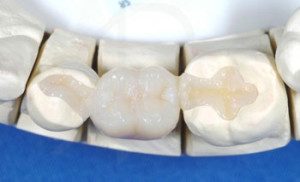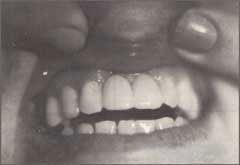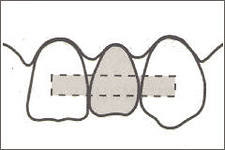Adhesive prosthetics
Adhesive prosthetics is a new progressive and effective technology offered by modern orthopedic dentists. It is a type of micro prosthetics.
Moreover, all the unpleasant procedures that patients fear due to the association with prosthetics are not required at all (for example, the same turning of the supporting teeth, their preparation, installation of the crown, depulpation and other inconveniences).
Even with the loss of only one of a number of teeth, traditional methods for its restoration involve the preparation of adjacent teeth and closing them with crowns. And using adhesive prosthetics, you can keep all healthy teeth intact, while restoring lost teeth. Such a problem as the loss of one tooth generally has a number of solutions, but adhesive micro-prosthetics is the most simple and effective technique.
Adhesive prosthetics without turning

As much as we would not like, but the turning of the supporting teeth is necessary for the installation of many types of prostheses. First of all, we mean a bridge (or "bridge"). The whole point of this method of prosthetics is that an artificial tooth or a number of them is fixed to the crowns.
They are put on healthy teeth, which serve as the basis for crowns, on both sides of the empty space in the dentition. But in order to install the crown was possible, these abutment teeth must be grinded.
With the help of modern sedatives, they try to facilitate this procedure, but it also remains unpleasant. And it is understandable that strong healthy teeth are a pity to spoil for the sake of this procedure. Fortunately, a new high-tech method has appeared in modern medicine, which allows you to restore your teeth without turning their healthy "neighbors".
Adhesive prosthetics without turning is the most sparing method, because:
- teeth nerves persist;
- their enamel is not damaged;
- functional features remain the same;
- the life of the teeth is significantly increased.
The method of prosthetics without turning is divided into two groups:
- invasive (small grooves or holes are created in the teeth along the edges of the defect, and glass fiber supports or micro-locks are installed there, depending on the situation, after which the missing tooth is restored);
- non-invasive (supporting teeth remain intact; the optimal prosthetics technique is preselected, then impressions are made, the design is developed and the tooth is recreated).
The adhesive prosthetics procedure itself takes place in a strictly defined sequence:
- The specialist examines the patient, makes an anamnesis (he plays a big role for the clinical picture of the disease), makes a diagnosis and draws up a treatment plan.
- After the examination, a diagnosis is made using a computer RG-visiogram or electroodontodiagnosis.
- The oral cavity is prepared for prosthetics. The teeth are machined with diamond coated tools to improve the adhesion of the composite to enamel.
- Impressions are taken and working models are created. Color wax is applied.
- The surface of the teeth is treated with medicines, the teeth and prosthesis are coated with a composite. Then the excess is removed, and a special lamp is used for polymerisation. Bite correction occurs and teeth are polished.
Adhesive prostheses cannot be installed if:
- supporting teeth are badly damaged and are in the wrong position;
- teeth are mobile and easy to wear;
- there is a severe periodontal disease;
- the patient has a tendency to bite his nails;
- there are pathological tremas.
Video: Adhesive bridge
Adhesive Prosthetics Technology
Translated from Latin, “adhaesio” literally means “sticking”. This gave the name to this method, because the prosthesis is attached to the abutment teeth thanks to a special glue. The technology of adhesive prosthetics is as follows. To begin with, there are two main methods that are used with this method.
One of them involves applying micro notches to the supporting teeth.

It takes place in several stages:
- Notching (if there are seals, they can be cut).
- Laying and fixing in the formed recesses of fiberglass threads, which provide stability and high strength for the future prosthesis.
- The use of cermets or composite materials to restore a lost tooth. It is quite difficult and time-consuming to make a ceramic-metal prosthesis, therefore this process is carried out in dental laboratories for the casting of teeth, which is done previously in the dental office. Most often, ceramic-metal adhesives are used for bridge prosthetics.
- Installation of an adhesive prosthesis.
- Adjustment or adjustment (if necessary) using special tools.
The second option is the so-called Maryland Bridge.
It also represents a prosthesis attached to abutment teeth, but not with the help of fiberglass threads, but with the use of metal pads. This method has been successfully used by orthopedic dentists since 1973.
In this case, the supporting teeth are also not grinded, and instead the lingual surface of the teeth is only slightly etched. Support elements are attached to it. The installation time (for example, one or two visits) depends on what material was used to make the prosthesis. Maryland Bridge is made of cermet or metal in special dental laboratories. A photo will help you become more familiar with all the information.
Adhesive Denture Prices
There are various types of adhesive prostheses and, of course, they all have different costs. For example, the adhesive prosthesis “butterfly” is one of the most popular because the price for it is much lower than for other prostheses.
"Butterflies" are conveniently worn and quickly get used to them.

However, in order to make a splint adhesive prosthesis, the costs of materials and its manufacture are needed, therefore, such a service has a corresponding cost. Prices may fluctuate depending on the materials and the complexity of the design, so for Russia these are amounts within 3.6 thousand rubles up to 16 thousand rub.
And regardless of the cost, this procedure is worth it, because the adhesive prosthetics technology is suitable for absolutely all ages: from young patients to elderly people, even after suffering heart attacks and strokes. Therefore, beautiful and healthy teeth are now available to everyone without unnecessary losses and the most pleasant sensations.
